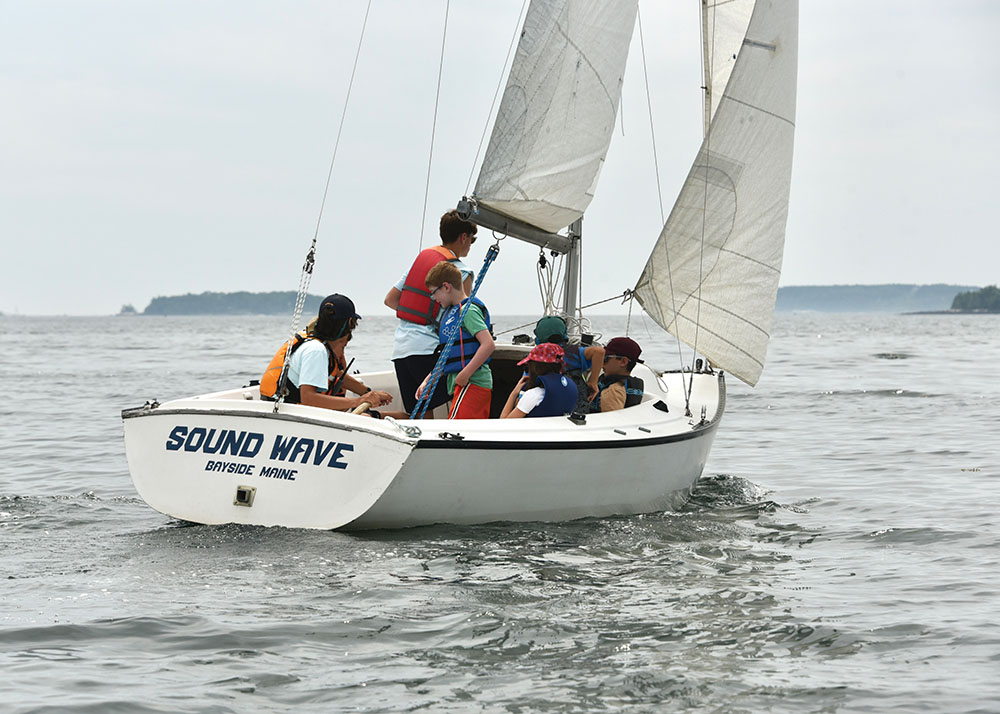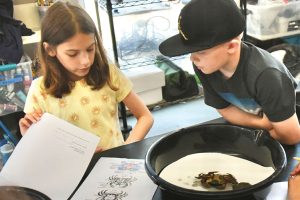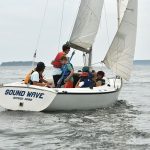
As the weather begins to cool and the first leaves start falling, we look back on our 2025 summer season with great joy and feelings of success. Attendance increased to 211 students (171 in 2024) totaling 535 weeks (487 in 2024). In addition, we were able to offer financial assistance totaling $16,187 to 15 students. From June 16 to August 15, we covered a wide range of contemporary sea and science topics and skills ranging from boating and sailing, to aquaculture, art and culture, climate change and marine debris. And along the way we had lots of fun!
We especially want to thank the many community and parent volunteers who helped with driving and chaperoning field trips, serving at our weekly cookout, trash runs to the transfer station, and other day to day operations at the Center. We couldn’t do all of this without you.
 A chilly start
A chilly start
The first week of the season Ship to Shore:Discovering BSSC began with a cold plunge into Linekin Bay as students took their “swim test.” While rain, fog and wind limited our time on the water that week, the BSSC instructors found creative ways to teach the various aspects of boating and sailing that included mastering knot tying using the knot relay race, measuring wind speed and direction using data collected by our weather station, charting their next sailing course on Linekin Bay and mastering the use of a compass.
We also got to spend time using our simulator … a land-based Turnabout sailboat that is fully rigged and mounted on a platform that allows us to practice our skills at rigging, derigging and sail trim regardless of the weather.
Schooner Tyrone
During the last full week of June students Charles Record, Blythe Miller, Lettie Wilson, Luca Fuentes, and Emmett Record and Science Instructor Amelia Lang spent four days and 3 nights with Captain Rayford Chew and first mate Carolyn Corbin on the Schooner Tyrone where they experienced real-time at-sea sailing and marine science. The students engaged in a wide range of experiential activities that included how to plot a course, weather observation and forecasting, sail trimming, and knot tying … to name a few. The students also studied and recorded data of water samples collected during their voyage. And they learned about day-to-day life at sea that included cooking meals, keeping watch, and boat safety.
At the conclusion of the voyage, Captain Rayford wrote: “The trip was quite successful and we were so happy to have the kids aboard. I think everyone was challenged, learned had a lot of fun and grew a bit with some memories they won’t soon forget.”
Field Trips
While the shore, tidepools and Linekin Bay provide incredible learning opportunities, we also explored beyond our campus. At the Bowdoin College Peary-MacMillan Arctic Museum, Curator Genny LeMoine taught us about the lives of indigenous people living in the Arctic region. And at the Schiller Coastal Studies Center with Director Holly Parker we learned about tides and their impact on coastal communities and how humans are impacting our sea and land.
During the summer we also attended the open house at Bigelow Laboratory for Ocean Sciences, an annual favorite since 2013, where we gained a better understanding of ocean acidification and conducted a hands-on experiment extracting DNA of strawberries.
Out and about in our community a morning with sailmaker Sherman “Sherm” Brewer at his sail loft broadened our understanding of the relevance of sail design and sailcloth. At our annual visit to the Boothbay Region Refuse Transfer Station we talked with Rena Smith, assistant foreman, about what happens to our trash after we drop it in the dumpster. We left there with a much better understanding about the important of recycling and the difference between a landfill and a transfer station.
During our last week we toured the Shipyard in Boothbay Harbor and the Brig Niagra that is currently on the ways at the Shipyard. A very special thank you to Shipwright Ross Branch (BSSC parent) for explaining the day-to-day operations of the Shipyard and to Captain Bailey for sharing Niagra’s rich history.
Speakers
This summer we welcomed many speakers who brought their knowledge and passion to our campus. These included Capt. George Messner (BSSC parent) from the U.S. Navy who shared his experience with extreme weather phenomena, Steve and Pam Meserve of Lewis Fishery who talked with us about their shad fishery on Lewis Island in the Delaware River and Dr. Nick Record, a scientist at Bigelow Laboratory who expanded our understanding of jellyfish. Captain Charlie Peary told us about his “Great Loop” adventure. Emma Dullaert, a UMaine doctoral student, shared her research on lobster molting, and Kyle Olivera, Post-Doc at Bigelow Laboratory, described his e-DNA research using “drifters” and worked with us designing and building mock-ups of drifters using disposable cups and pool noodles. Oceanographer David Brooks spoke to us about the impact of rising sea levels.
Sarah Redmond, owner and operator of Springtide Seaweed traveled to our campus to talk with us about the seaweed aquaculture industry and its growing presence in Maine. Sarah supplies us with the sugar kelp (Saccharina latissama) seedlings and Alaria (Alaria esculenta) seedlings for our in-school Exploring the Science of Seaweed Farming program.
We were also honored to have Jen Betts, Children’s Coordinator at the Boothbay Memorial Library, who brought weekly story time to our Mizzen students.
Sailing
Safety at sea, learning to sail, continuously refining our skills, and integrating science are some of the key elements in the sailing portion of our program. Our fleet of boats that includes Turnabouts, Sonars, Precision-15, Rhodes 19, kayaks, and rowboats give everyone an opportunity to get out on the water and experience the joys and challenges of the real-world conditions presented by the wind, tides, currents and weather on Linekin Bay. In addition we learn the specific nomenclature for lines, sails and boat structure and study the weather … integrating the science and the sea. This summer we introduced the “skill bead bracelet”. A different color bead for each skill achieved that included knot tying, rigging, derigging, tacking, jibbing, sailing-off and landing-on the haul-off and kindness.
Science
“Science” is part of our name and it’s a major part of our mission. Each day we learn about the ocean that includes everything from the physics of tides and currents, to the chemistry of the water, to the biology of the creatures that make their homes in the open ocean as well as those found protected in the tidepools on the shore of our campus. We use microscopes, touch tanks, seining nets, dissection kits, binoculars, scales, magnifying glasses, and guides/reference materials to help us gain a better understanding of ecosystems.
In addition to a broad overview of marine science, we drill down into contemporary ocean science topics such as the effect of microplastics in the sea and the current cutting edge technology being used to remove this debris from the ocean. And with the learning we challenge our students to design and defend their own solutions.
Arts and Culture
As part of our integrated approach to understanding our maritime history we embrace the art and culture of our region. This summer we enjoyed a live performance by Castlebay of rich ballads that blended history and the legends of the sea. We explored the practice of storytelling by creating our own ballads. Thanks to the generosity of Kate Horgan (BSSC Grandparent) we were gifted an “art cart” that included woodblocks and related art materials that were specifically designed for the Boothbay Sea and Science Center by the Villard Studio. We are most grateful for the gift and the support we received from Kim and Philippe on how to use the cart.

